Principles of Project Management: Singular Logic Case Study Report
VerifiedAdded on 2022/09/05
|9
|2041
|21
Report
AI Summary
This report presents a case study analysis of Singular Logic, focusing on project management principles. It begins with an introduction to project management, defining its core elements and constraints. The report then delves into project selection methods, categorizing them into constrained optimization and benefit measurement techniques, including cost-benefit ratio, economic models, payback period, net present value, and opportunity costs. The process for conducting these selection methods is also outlined. The report further examines project initiation documents, specifically project cost management, schedule management, and scope management, detailing their significance. A case study analysis of Singular Logic is provided, highlighting its project lead times, resource needs, and the importance of benefit measurement methods. The report concludes by emphasizing the goal of project management: to produce a project that meets client objectives, referencing the provided details on the case study.
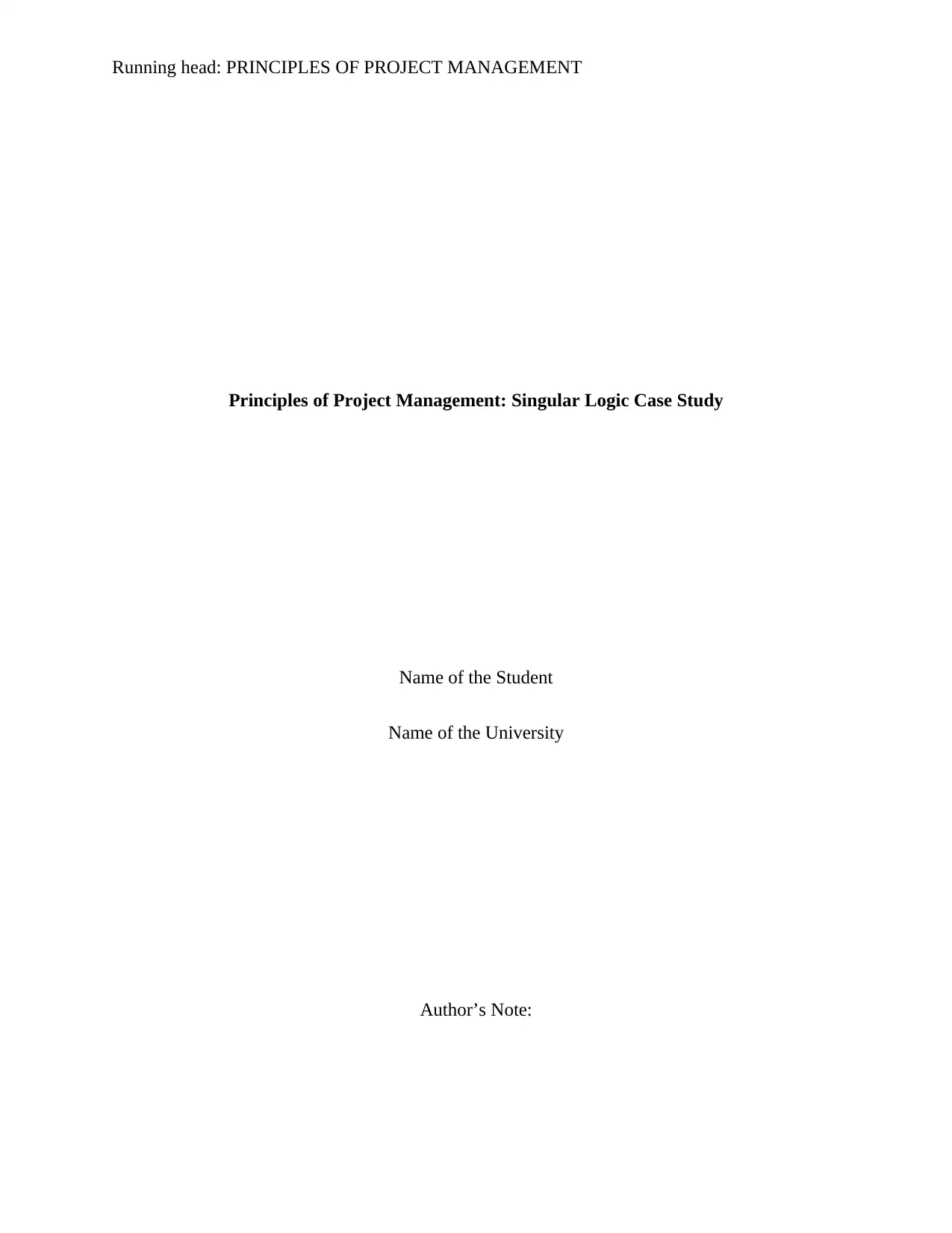
Running head: PRINCIPLES OF PROJECT MANAGEMENT
Principles of Project Management: Singular Logic Case Study
Name of the Student
Name of the University
Author’s Note:
Principles of Project Management: Singular Logic Case Study
Name of the Student
Name of the University
Author’s Note:
Paraphrase This Document
Need a fresh take? Get an instant paraphrase of this document with our AI Paraphraser
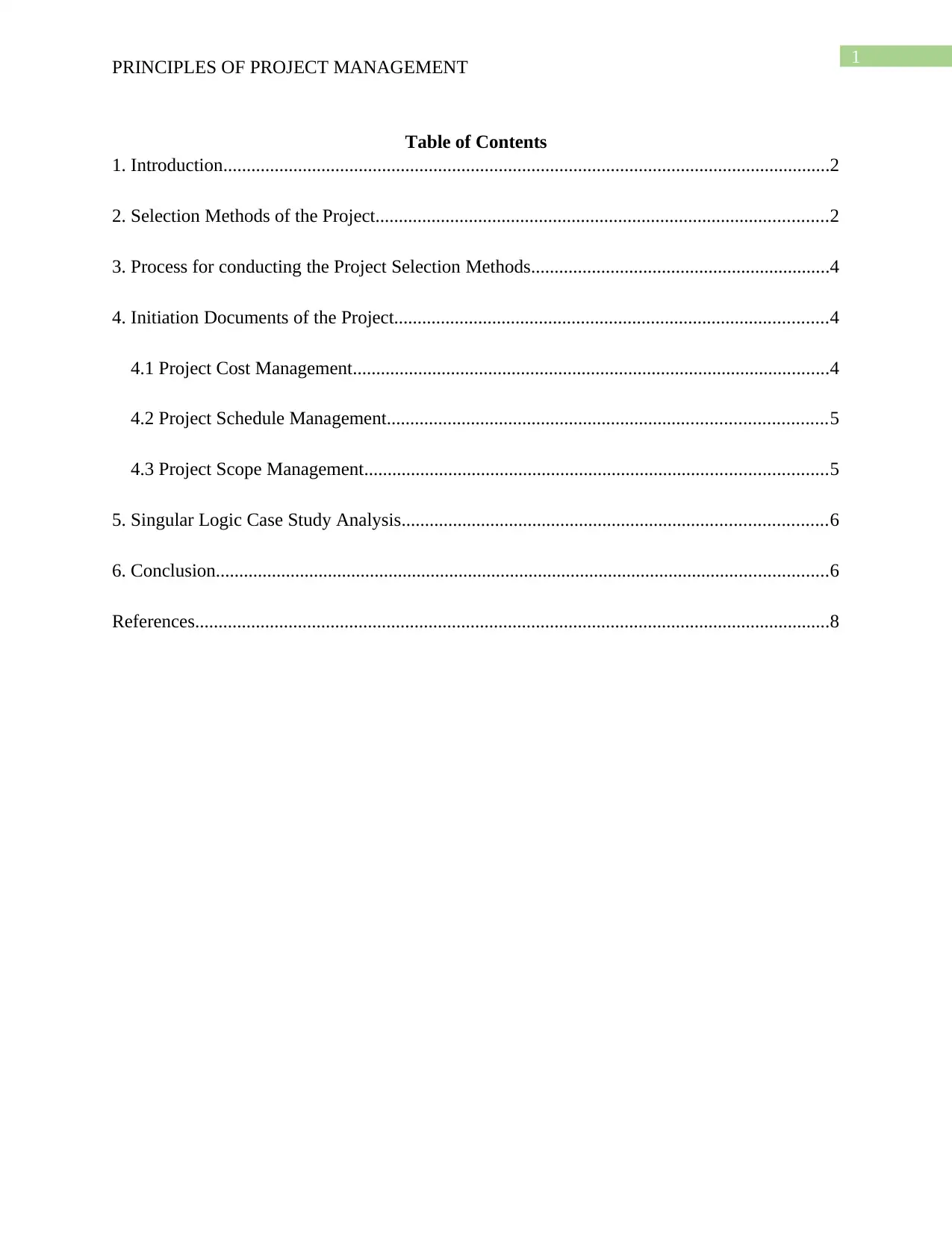
1
PRINCIPLES OF PROJECT MANAGEMENT
Table of Contents
1. Introduction..................................................................................................................................2
2. Selection Methods of the Project.................................................................................................2
3. Process for conducting the Project Selection Methods................................................................4
4. Initiation Documents of the Project.............................................................................................4
4.1 Project Cost Management......................................................................................................4
4.2 Project Schedule Management..............................................................................................5
4.3 Project Scope Management...................................................................................................5
5. Singular Logic Case Study Analysis...........................................................................................6
6. Conclusion...................................................................................................................................6
References........................................................................................................................................8
PRINCIPLES OF PROJECT MANAGEMENT
Table of Contents
1. Introduction..................................................................................................................................2
2. Selection Methods of the Project.................................................................................................2
3. Process for conducting the Project Selection Methods................................................................4
4. Initiation Documents of the Project.............................................................................................4
4.1 Project Cost Management......................................................................................................4
4.2 Project Schedule Management..............................................................................................5
4.3 Project Scope Management...................................................................................................5
5. Singular Logic Case Study Analysis...........................................................................................6
6. Conclusion...................................................................................................................................6
References........................................................................................................................................8
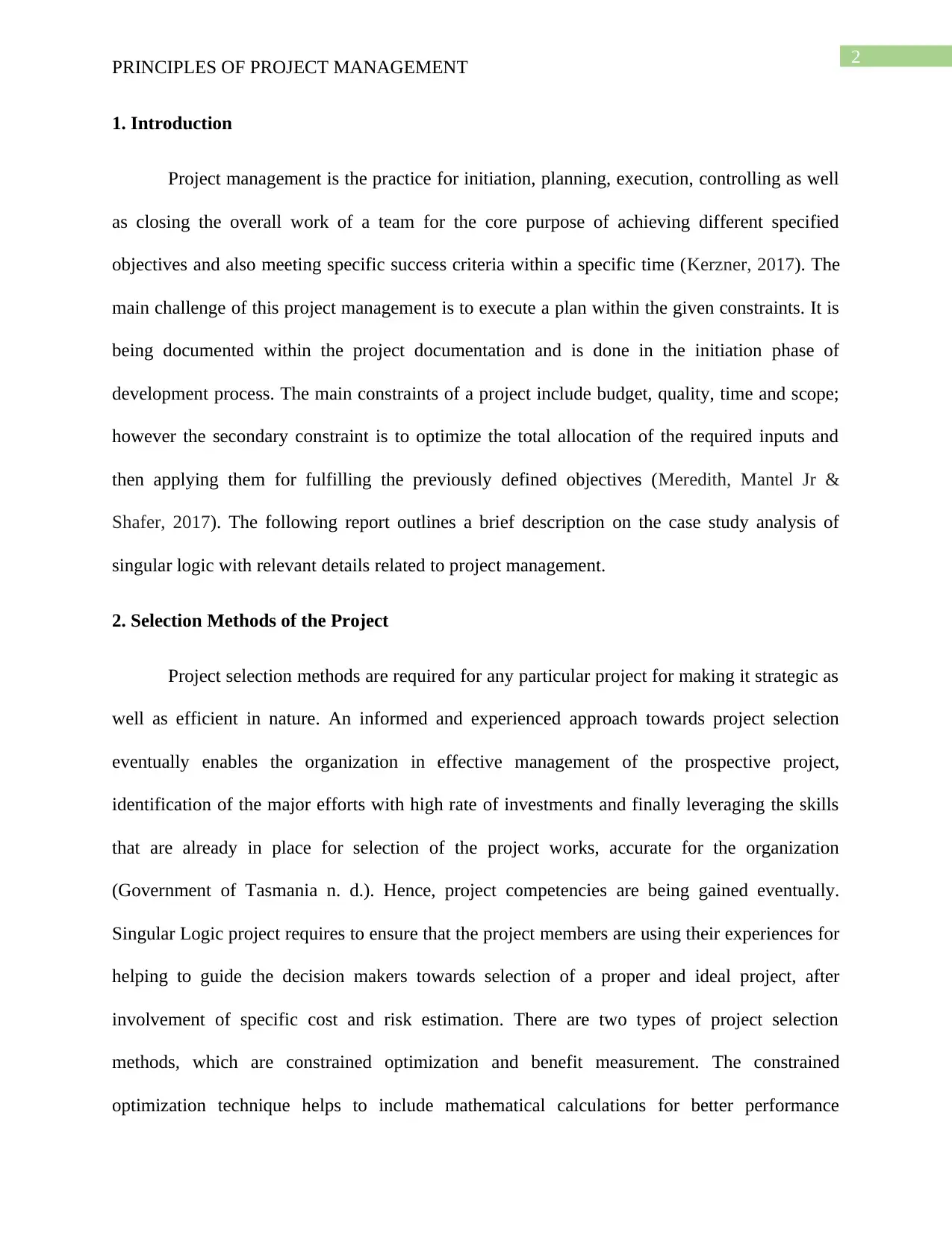
2
PRINCIPLES OF PROJECT MANAGEMENT
1. Introduction
Project management is the practice for initiation, planning, execution, controlling as well
as closing the overall work of a team for the core purpose of achieving different specified
objectives and also meeting specific success criteria within a specific time (Kerzner, 2017). The
main challenge of this project management is to execute a plan within the given constraints. It is
being documented within the project documentation and is done in the initiation phase of
development process. The main constraints of a project include budget, quality, time and scope;
however the secondary constraint is to optimize the total allocation of the required inputs and
then applying them for fulfilling the previously defined objectives (Meredith, Mantel Jr &
Shafer, 2017). The following report outlines a brief description on the case study analysis of
singular logic with relevant details related to project management.
2. Selection Methods of the Project
Project selection methods are required for any particular project for making it strategic as
well as efficient in nature. An informed and experienced approach towards project selection
eventually enables the organization in effective management of the prospective project,
identification of the major efforts with high rate of investments and finally leveraging the skills
that are already in place for selection of the project works, accurate for the organization
(Government of Tasmania n. d.). Hence, project competencies are being gained eventually.
Singular Logic project requires to ensure that the project members are using their experiences for
helping to guide the decision makers towards selection of a proper and ideal project, after
involvement of specific cost and risk estimation. There are two types of project selection
methods, which are constrained optimization and benefit measurement. The constrained
optimization technique helps to include mathematical calculations for better performance
PRINCIPLES OF PROJECT MANAGEMENT
1. Introduction
Project management is the practice for initiation, planning, execution, controlling as well
as closing the overall work of a team for the core purpose of achieving different specified
objectives and also meeting specific success criteria within a specific time (Kerzner, 2017). The
main challenge of this project management is to execute a plan within the given constraints. It is
being documented within the project documentation and is done in the initiation phase of
development process. The main constraints of a project include budget, quality, time and scope;
however the secondary constraint is to optimize the total allocation of the required inputs and
then applying them for fulfilling the previously defined objectives (Meredith, Mantel Jr &
Shafer, 2017). The following report outlines a brief description on the case study analysis of
singular logic with relevant details related to project management.
2. Selection Methods of the Project
Project selection methods are required for any particular project for making it strategic as
well as efficient in nature. An informed and experienced approach towards project selection
eventually enables the organization in effective management of the prospective project,
identification of the major efforts with high rate of investments and finally leveraging the skills
that are already in place for selection of the project works, accurate for the organization
(Government of Tasmania n. d.). Hence, project competencies are being gained eventually.
Singular Logic project requires to ensure that the project members are using their experiences for
helping to guide the decision makers towards selection of a proper and ideal project, after
involvement of specific cost and risk estimation. There are two types of project selection
methods, which are constrained optimization and benefit measurement. The constrained
optimization technique helps to include mathematical calculations for better performance
⊘ This is a preview!⊘
Do you want full access?
Subscribe today to unlock all pages.

Trusted by 1+ million students worldwide
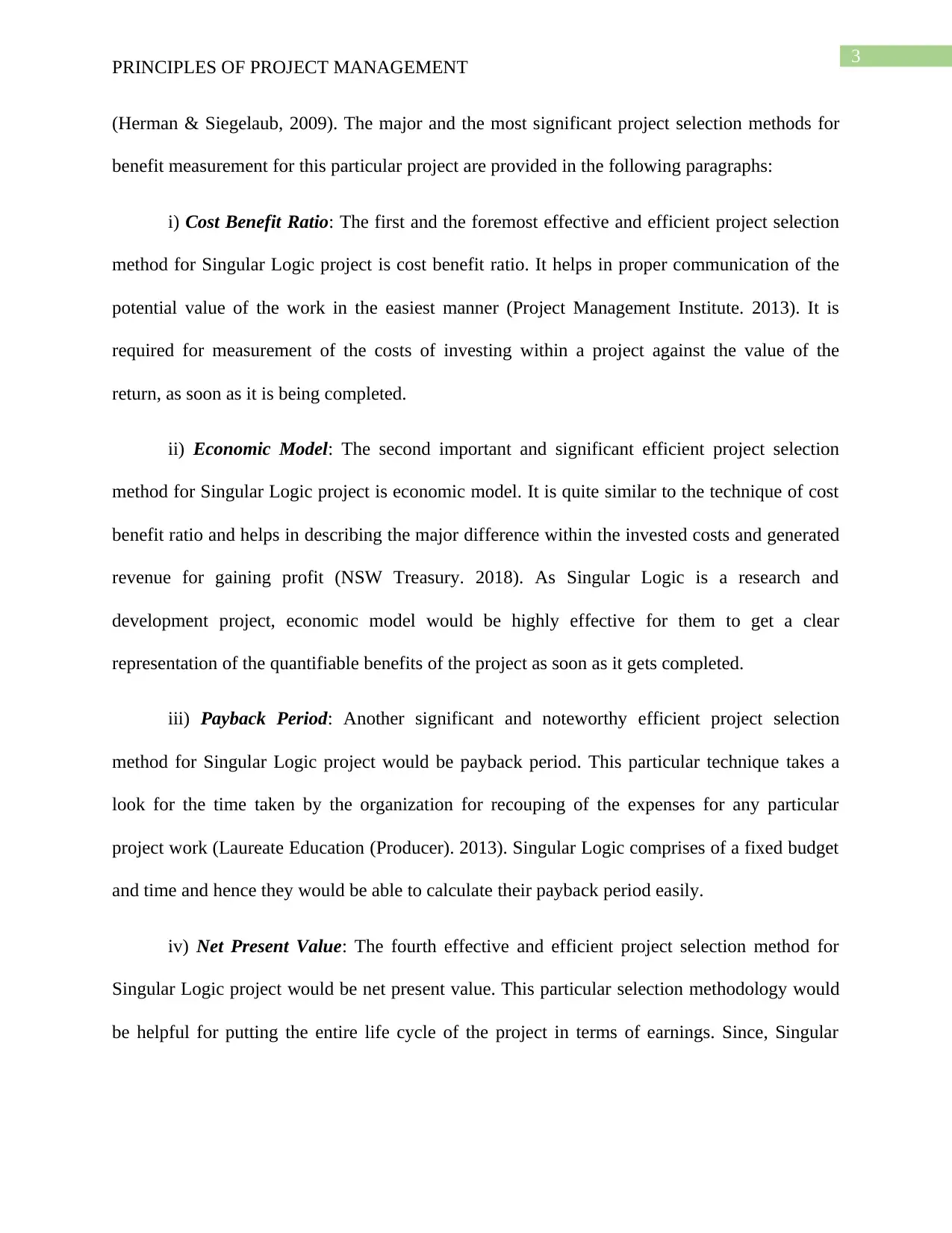
3
PRINCIPLES OF PROJECT MANAGEMENT
(Herman & Siegelaub, 2009). The major and the most significant project selection methods for
benefit measurement for this particular project are provided in the following paragraphs:
i) Cost Benefit Ratio: The first and the foremost effective and efficient project selection
method for Singular Logic project is cost benefit ratio. It helps in proper communication of the
potential value of the work in the easiest manner (Project Management Institute. 2013). It is
required for measurement of the costs of investing within a project against the value of the
return, as soon as it is being completed.
ii) Economic Model: The second important and significant efficient project selection
method for Singular Logic project is economic model. It is quite similar to the technique of cost
benefit ratio and helps in describing the major difference within the invested costs and generated
revenue for gaining profit (NSW Treasury. 2018). As Singular Logic is a research and
development project, economic model would be highly effective for them to get a clear
representation of the quantifiable benefits of the project as soon as it gets completed.
iii) Payback Period: Another significant and noteworthy efficient project selection
method for Singular Logic project would be payback period. This particular technique takes a
look for the time taken by the organization for recouping of the expenses for any particular
project work (Laureate Education (Producer). 2013). Singular Logic comprises of a fixed budget
and time and hence they would be able to calculate their payback period easily.
iv) Net Present Value: The fourth effective and efficient project selection method for
Singular Logic project would be net present value. This particular selection methodology would
be helpful for putting the entire life cycle of the project in terms of earnings. Since, Singular
PRINCIPLES OF PROJECT MANAGEMENT
(Herman & Siegelaub, 2009). The major and the most significant project selection methods for
benefit measurement for this particular project are provided in the following paragraphs:
i) Cost Benefit Ratio: The first and the foremost effective and efficient project selection
method for Singular Logic project is cost benefit ratio. It helps in proper communication of the
potential value of the work in the easiest manner (Project Management Institute. 2013). It is
required for measurement of the costs of investing within a project against the value of the
return, as soon as it is being completed.
ii) Economic Model: The second important and significant efficient project selection
method for Singular Logic project is economic model. It is quite similar to the technique of cost
benefit ratio and helps in describing the major difference within the invested costs and generated
revenue for gaining profit (NSW Treasury. 2018). As Singular Logic is a research and
development project, economic model would be highly effective for them to get a clear
representation of the quantifiable benefits of the project as soon as it gets completed.
iii) Payback Period: Another significant and noteworthy efficient project selection
method for Singular Logic project would be payback period. This particular technique takes a
look for the time taken by the organization for recouping of the expenses for any particular
project work (Laureate Education (Producer). 2013). Singular Logic comprises of a fixed budget
and time and hence they would be able to calculate their payback period easily.
iv) Net Present Value: The fourth effective and efficient project selection method for
Singular Logic project would be net present value. This particular selection methodology would
be helpful for putting the entire life cycle of the project in terms of earnings. Since, Singular
Paraphrase This Document
Need a fresh take? Get an instant paraphrase of this document with our AI Paraphraser
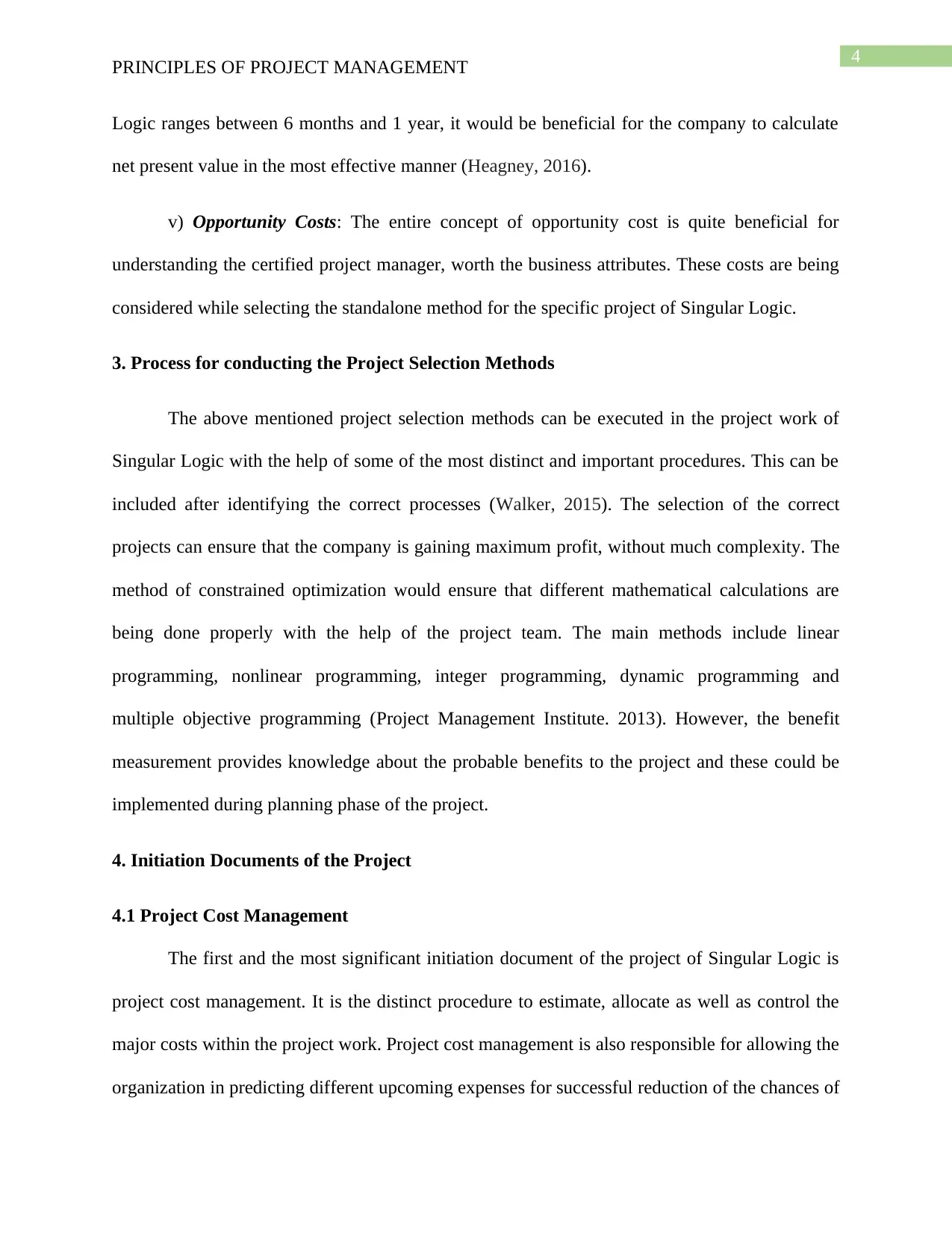
4
PRINCIPLES OF PROJECT MANAGEMENT
Logic ranges between 6 months and 1 year, it would be beneficial for the company to calculate
net present value in the most effective manner (Heagney, 2016).
v) Opportunity Costs: The entire concept of opportunity cost is quite beneficial for
understanding the certified project manager, worth the business attributes. These costs are being
considered while selecting the standalone method for the specific project of Singular Logic.
3. Process for conducting the Project Selection Methods
The above mentioned project selection methods can be executed in the project work of
Singular Logic with the help of some of the most distinct and important procedures. This can be
included after identifying the correct processes (Walker, 2015). The selection of the correct
projects can ensure that the company is gaining maximum profit, without much complexity. The
method of constrained optimization would ensure that different mathematical calculations are
being done properly with the help of the project team. The main methods include linear
programming, nonlinear programming, integer programming, dynamic programming and
multiple objective programming (Project Management Institute. 2013). However, the benefit
measurement provides knowledge about the probable benefits to the project and these could be
implemented during planning phase of the project.
4. Initiation Documents of the Project
4.1 Project Cost Management
The first and the most significant initiation document of the project of Singular Logic is
project cost management. It is the distinct procedure to estimate, allocate as well as control the
major costs within the project work. Project cost management is also responsible for allowing the
organization in predicting different upcoming expenses for successful reduction of the chances of
PRINCIPLES OF PROJECT MANAGEMENT
Logic ranges between 6 months and 1 year, it would be beneficial for the company to calculate
net present value in the most effective manner (Heagney, 2016).
v) Opportunity Costs: The entire concept of opportunity cost is quite beneficial for
understanding the certified project manager, worth the business attributes. These costs are being
considered while selecting the standalone method for the specific project of Singular Logic.
3. Process for conducting the Project Selection Methods
The above mentioned project selection methods can be executed in the project work of
Singular Logic with the help of some of the most distinct and important procedures. This can be
included after identifying the correct processes (Walker, 2015). The selection of the correct
projects can ensure that the company is gaining maximum profit, without much complexity. The
method of constrained optimization would ensure that different mathematical calculations are
being done properly with the help of the project team. The main methods include linear
programming, nonlinear programming, integer programming, dynamic programming and
multiple objective programming (Project Management Institute. 2013). However, the benefit
measurement provides knowledge about the probable benefits to the project and these could be
implemented during planning phase of the project.
4. Initiation Documents of the Project
4.1 Project Cost Management
The first and the most significant initiation document of the project of Singular Logic is
project cost management. It is the distinct procedure to estimate, allocate as well as control the
major costs within the project work. Project cost management is also responsible for allowing the
organization in predicting different upcoming expenses for successful reduction of the chances of
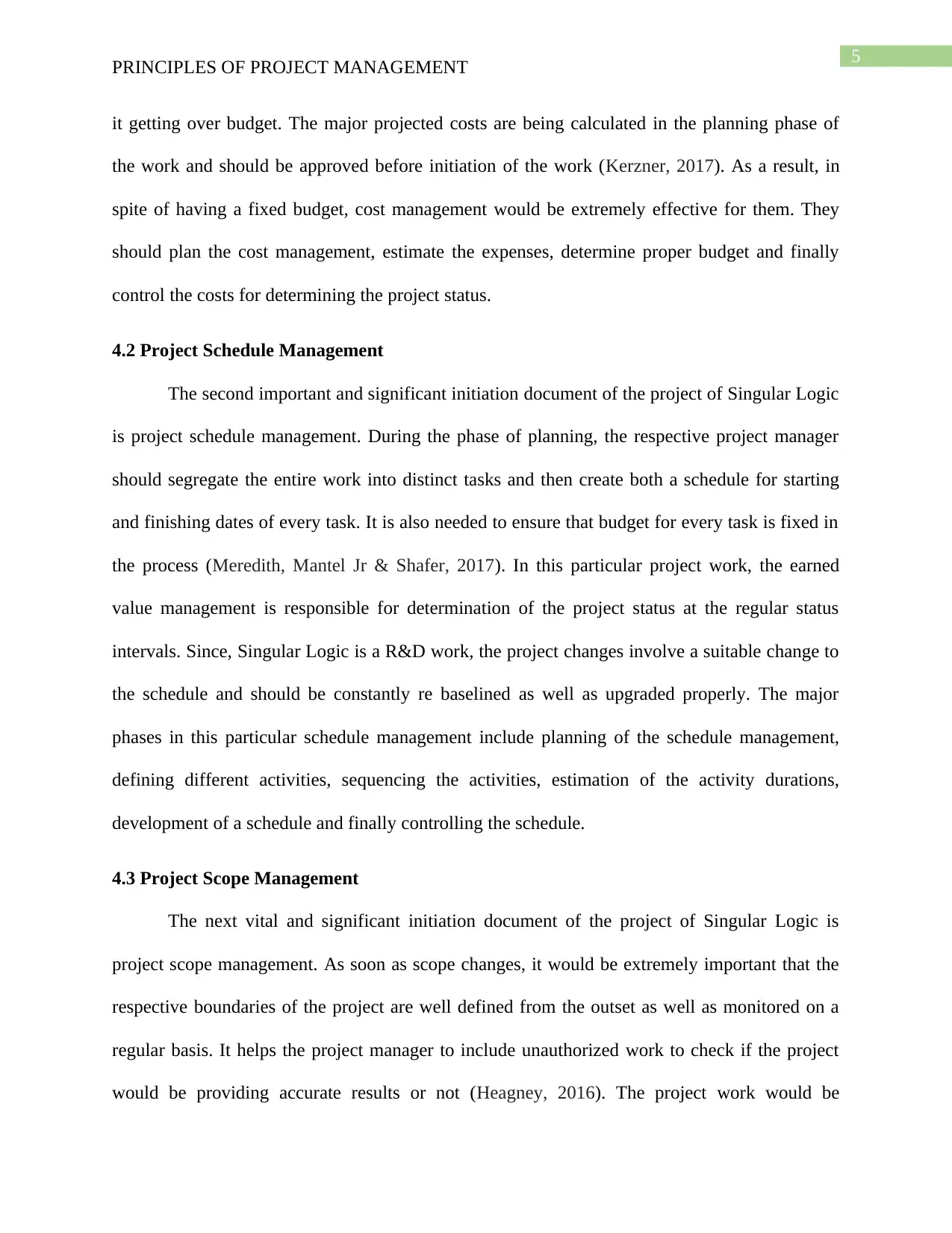
5
PRINCIPLES OF PROJECT MANAGEMENT
it getting over budget. The major projected costs are being calculated in the planning phase of
the work and should be approved before initiation of the work (Kerzner, 2017). As a result, in
spite of having a fixed budget, cost management would be extremely effective for them. They
should plan the cost management, estimate the expenses, determine proper budget and finally
control the costs for determining the project status.
4.2 Project Schedule Management
The second important and significant initiation document of the project of Singular Logic
is project schedule management. During the phase of planning, the respective project manager
should segregate the entire work into distinct tasks and then create both a schedule for starting
and finishing dates of every task. It is also needed to ensure that budget for every task is fixed in
the process (Meredith, Mantel Jr & Shafer, 2017). In this particular project work, the earned
value management is responsible for determination of the project status at the regular status
intervals. Since, Singular Logic is a R&D work, the project changes involve a suitable change to
the schedule and should be constantly re baselined as well as upgraded properly. The major
phases in this particular schedule management include planning of the schedule management,
defining different activities, sequencing the activities, estimation of the activity durations,
development of a schedule and finally controlling the schedule.
4.3 Project Scope Management
The next vital and significant initiation document of the project of Singular Logic is
project scope management. As soon as scope changes, it would be extremely important that the
respective boundaries of the project are well defined from the outset as well as monitored on a
regular basis. It helps the project manager to include unauthorized work to check if the project
would be providing accurate results or not (Heagney, 2016). The project work would be
PRINCIPLES OF PROJECT MANAGEMENT
it getting over budget. The major projected costs are being calculated in the planning phase of
the work and should be approved before initiation of the work (Kerzner, 2017). As a result, in
spite of having a fixed budget, cost management would be extremely effective for them. They
should plan the cost management, estimate the expenses, determine proper budget and finally
control the costs for determining the project status.
4.2 Project Schedule Management
The second important and significant initiation document of the project of Singular Logic
is project schedule management. During the phase of planning, the respective project manager
should segregate the entire work into distinct tasks and then create both a schedule for starting
and finishing dates of every task. It is also needed to ensure that budget for every task is fixed in
the process (Meredith, Mantel Jr & Shafer, 2017). In this particular project work, the earned
value management is responsible for determination of the project status at the regular status
intervals. Since, Singular Logic is a R&D work, the project changes involve a suitable change to
the schedule and should be constantly re baselined as well as upgraded properly. The major
phases in this particular schedule management include planning of the schedule management,
defining different activities, sequencing the activities, estimation of the activity durations,
development of a schedule and finally controlling the schedule.
4.3 Project Scope Management
The next vital and significant initiation document of the project of Singular Logic is
project scope management. As soon as scope changes, it would be extremely important that the
respective boundaries of the project are well defined from the outset as well as monitored on a
regular basis. It helps the project manager to include unauthorized work to check if the project
would be providing accurate results or not (Heagney, 2016). The project work would be
⊘ This is a preview!⊘
Do you want full access?
Subscribe today to unlock all pages.

Trusted by 1+ million students worldwide
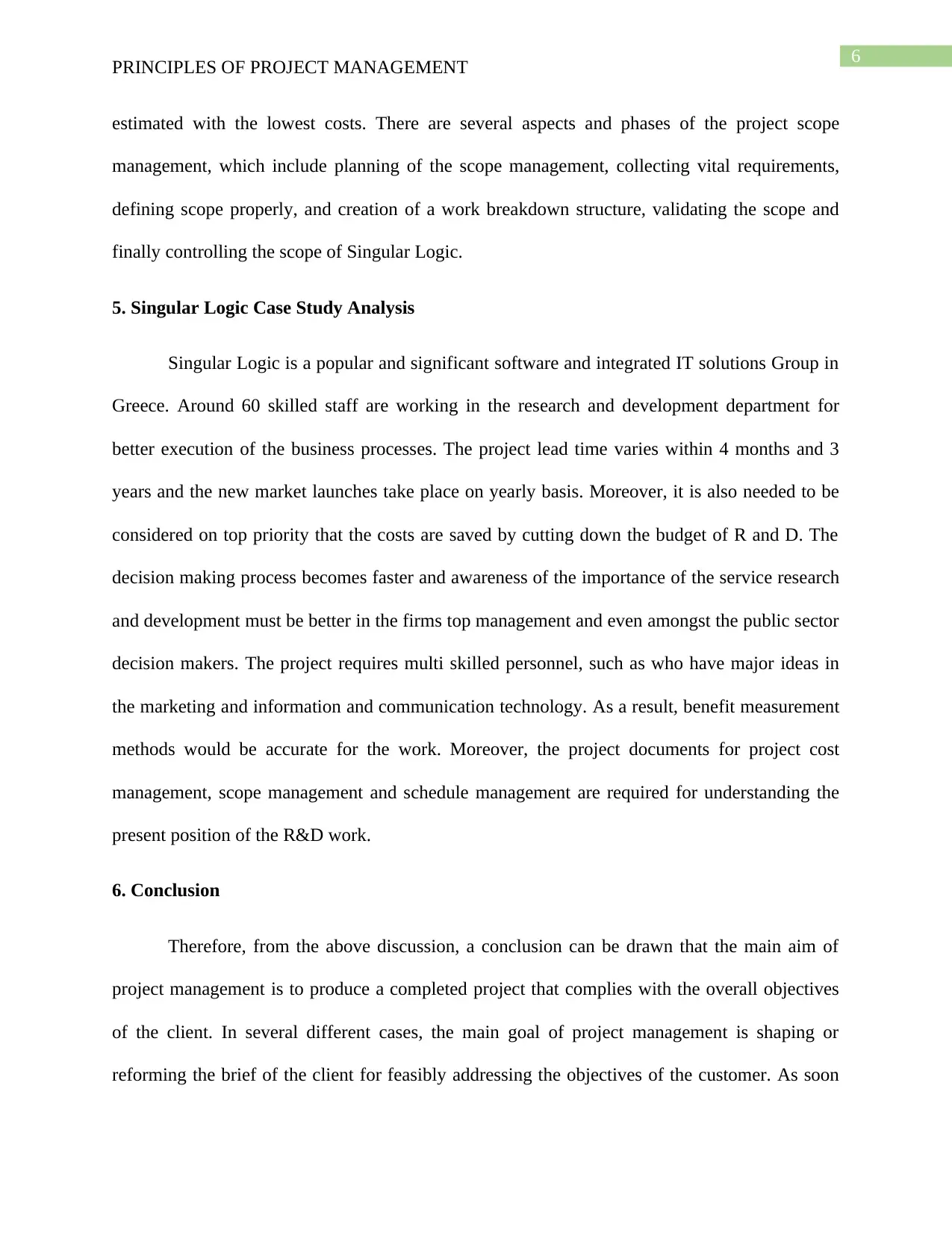
6
PRINCIPLES OF PROJECT MANAGEMENT
estimated with the lowest costs. There are several aspects and phases of the project scope
management, which include planning of the scope management, collecting vital requirements,
defining scope properly, and creation of a work breakdown structure, validating the scope and
finally controlling the scope of Singular Logic.
5. Singular Logic Case Study Analysis
Singular Logic is a popular and significant software and integrated IT solutions Group in
Greece. Around 60 skilled staff are working in the research and development department for
better execution of the business processes. The project lead time varies within 4 months and 3
years and the new market launches take place on yearly basis. Moreover, it is also needed to be
considered on top priority that the costs are saved by cutting down the budget of R and D. The
decision making process becomes faster and awareness of the importance of the service research
and development must be better in the firms top management and even amongst the public sector
decision makers. The project requires multi skilled personnel, such as who have major ideas in
the marketing and information and communication technology. As a result, benefit measurement
methods would be accurate for the work. Moreover, the project documents for project cost
management, scope management and schedule management are required for understanding the
present position of the R&D work.
6. Conclusion
Therefore, from the above discussion, a conclusion can be drawn that the main aim of
project management is to produce a completed project that complies with the overall objectives
of the client. In several different cases, the main goal of project management is shaping or
reforming the brief of the client for feasibly addressing the objectives of the customer. As soon
PRINCIPLES OF PROJECT MANAGEMENT
estimated with the lowest costs. There are several aspects and phases of the project scope
management, which include planning of the scope management, collecting vital requirements,
defining scope properly, and creation of a work breakdown structure, validating the scope and
finally controlling the scope of Singular Logic.
5. Singular Logic Case Study Analysis
Singular Logic is a popular and significant software and integrated IT solutions Group in
Greece. Around 60 skilled staff are working in the research and development department for
better execution of the business processes. The project lead time varies within 4 months and 3
years and the new market launches take place on yearly basis. Moreover, it is also needed to be
considered on top priority that the costs are saved by cutting down the budget of R and D. The
decision making process becomes faster and awareness of the importance of the service research
and development must be better in the firms top management and even amongst the public sector
decision makers. The project requires multi skilled personnel, such as who have major ideas in
the marketing and information and communication technology. As a result, benefit measurement
methods would be accurate for the work. Moreover, the project documents for project cost
management, scope management and schedule management are required for understanding the
present position of the R&D work.
6. Conclusion
Therefore, from the above discussion, a conclusion can be drawn that the main aim of
project management is to produce a completed project that complies with the overall objectives
of the client. In several different cases, the main goal of project management is shaping or
reforming the brief of the client for feasibly addressing the objectives of the customer. As soon
Paraphrase This Document
Need a fresh take? Get an instant paraphrase of this document with our AI Paraphraser
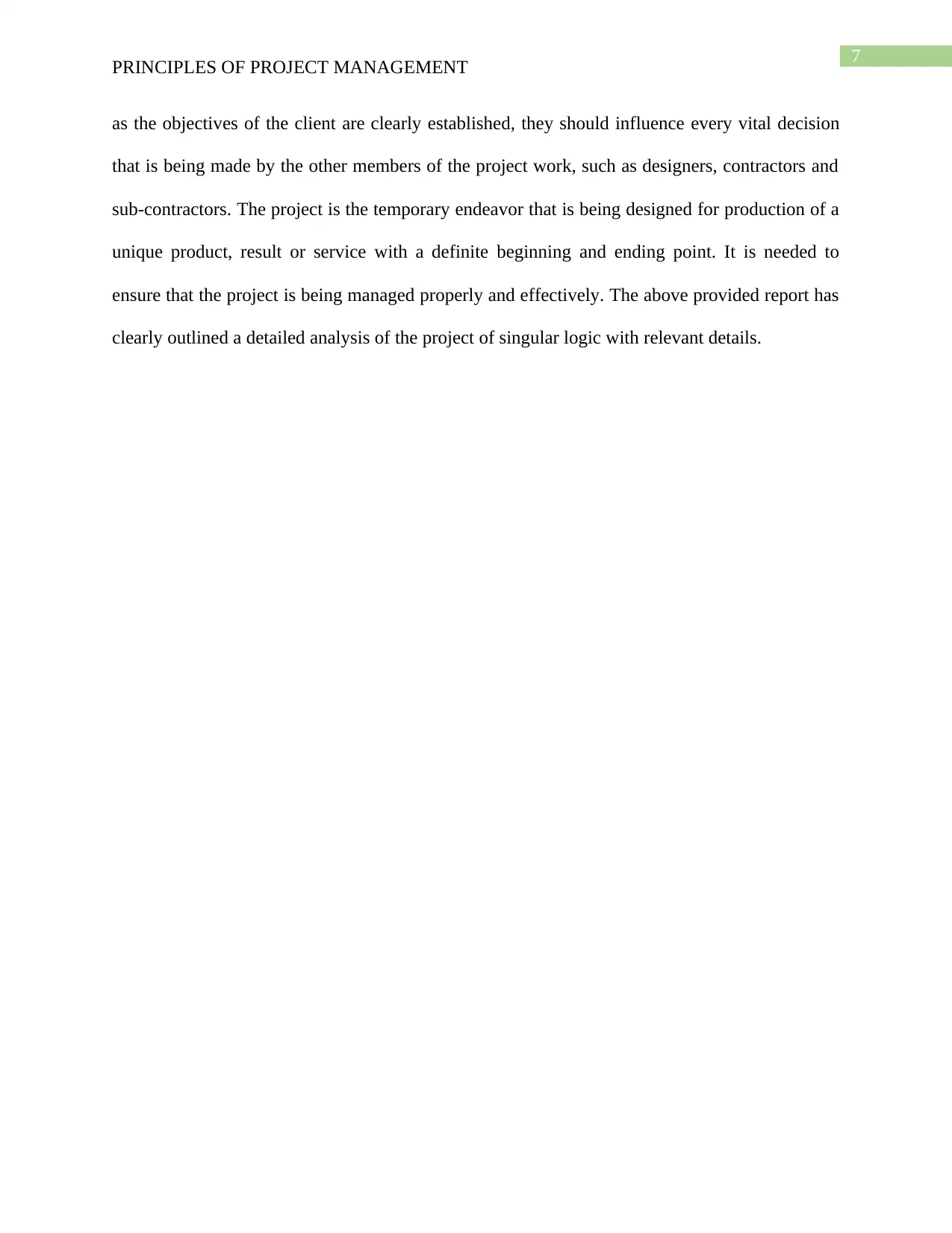
7
PRINCIPLES OF PROJECT MANAGEMENT
as the objectives of the client are clearly established, they should influence every vital decision
that is being made by the other members of the project work, such as designers, contractors and
sub-contractors. The project is the temporary endeavor that is being designed for production of a
unique product, result or service with a definite beginning and ending point. It is needed to
ensure that the project is being managed properly and effectively. The above provided report has
clearly outlined a detailed analysis of the project of singular logic with relevant details.
PRINCIPLES OF PROJECT MANAGEMENT
as the objectives of the client are clearly established, they should influence every vital decision
that is being made by the other members of the project work, such as designers, contractors and
sub-contractors. The project is the temporary endeavor that is being designed for production of a
unique product, result or service with a definite beginning and ending point. It is needed to
ensure that the project is being managed properly and effectively. The above provided report has
clearly outlined a detailed analysis of the project of singular logic with relevant details.
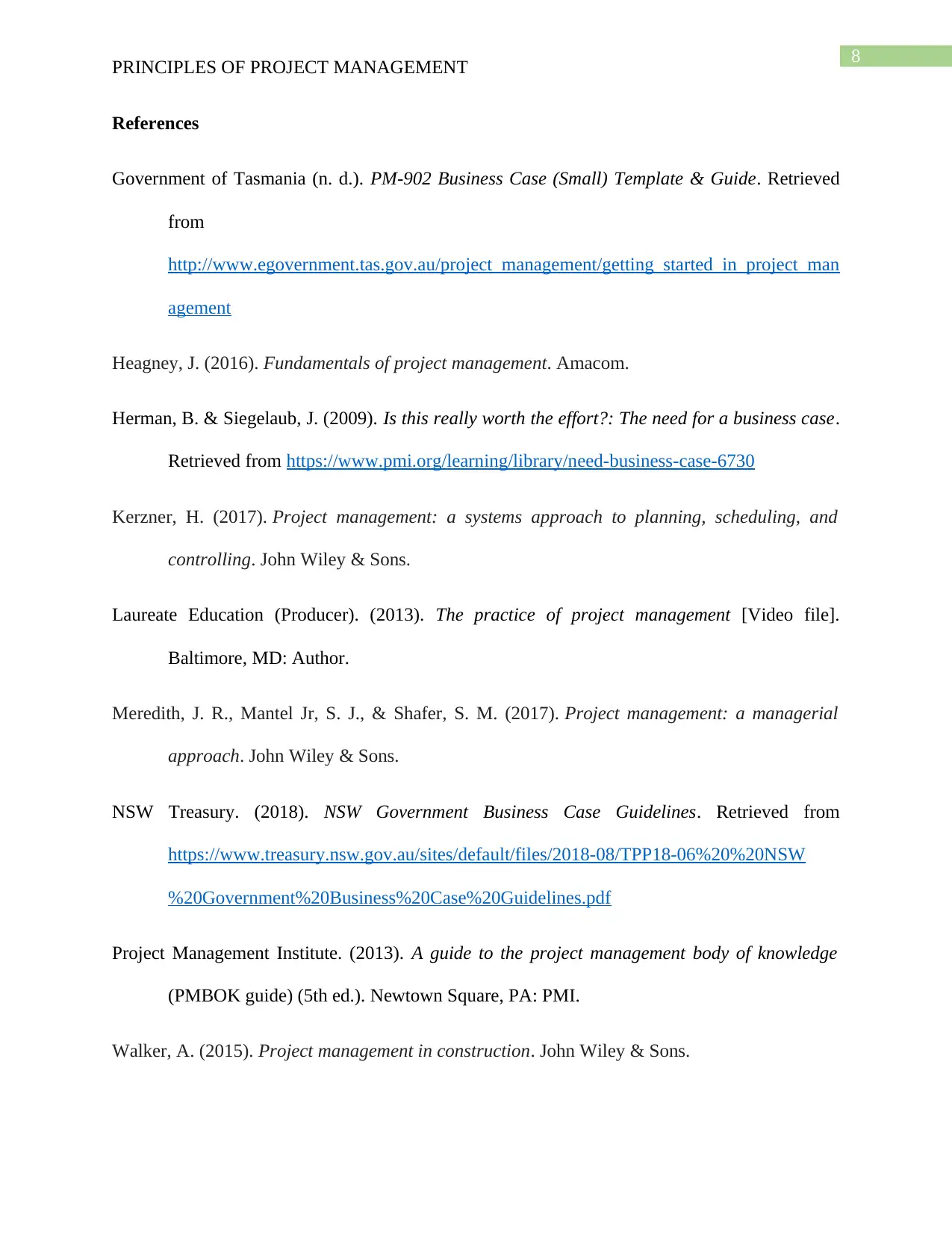
8
PRINCIPLES OF PROJECT MANAGEMENT
References
Government of Tasmania (n. d.). PM-902 Business Case (Small) Template & Guide. Retrieved
from
http://www.egovernment.tas.gov.au/project_management/getting_started_in_project_man
agement
Heagney, J. (2016). Fundamentals of project management. Amacom.
Herman, B. & Siegelaub, J. (2009). Is this really worth the effort?: The need for a business case.
Retrieved from https://www.pmi.org/learning/library/need-business-case-6730
Kerzner, H. (2017). Project management: a systems approach to planning, scheduling, and
controlling. John Wiley & Sons.
Laureate Education (Producer). (2013). The practice of project management [Video file].
Baltimore, MD: Author.
Meredith, J. R., Mantel Jr, S. J., & Shafer, S. M. (2017). Project management: a managerial
approach. John Wiley & Sons.
NSW Treasury. (2018). NSW Government Business Case Guidelines. Retrieved from
https://www.treasury.nsw.gov.au/sites/default/files/2018-08/TPP18-06%20%20NSW
%20Government%20Business%20Case%20Guidelines.pdf
Project Management Institute. (2013). A guide to the project management body of knowledge
(PMBOK guide) (5th ed.). Newtown Square, PA: PMI.
Walker, A. (2015). Project management in construction. John Wiley & Sons.
PRINCIPLES OF PROJECT MANAGEMENT
References
Government of Tasmania (n. d.). PM-902 Business Case (Small) Template & Guide. Retrieved
from
http://www.egovernment.tas.gov.au/project_management/getting_started_in_project_man
agement
Heagney, J. (2016). Fundamentals of project management. Amacom.
Herman, B. & Siegelaub, J. (2009). Is this really worth the effort?: The need for a business case.
Retrieved from https://www.pmi.org/learning/library/need-business-case-6730
Kerzner, H. (2017). Project management: a systems approach to planning, scheduling, and
controlling. John Wiley & Sons.
Laureate Education (Producer). (2013). The practice of project management [Video file].
Baltimore, MD: Author.
Meredith, J. R., Mantel Jr, S. J., & Shafer, S. M. (2017). Project management: a managerial
approach. John Wiley & Sons.
NSW Treasury. (2018). NSW Government Business Case Guidelines. Retrieved from
https://www.treasury.nsw.gov.au/sites/default/files/2018-08/TPP18-06%20%20NSW
%20Government%20Business%20Case%20Guidelines.pdf
Project Management Institute. (2013). A guide to the project management body of knowledge
(PMBOK guide) (5th ed.). Newtown Square, PA: PMI.
Walker, A. (2015). Project management in construction. John Wiley & Sons.
⊘ This is a preview!⊘
Do you want full access?
Subscribe today to unlock all pages.

Trusted by 1+ million students worldwide
1 out of 9
Related Documents
Your All-in-One AI-Powered Toolkit for Academic Success.
+13062052269
info@desklib.com
Available 24*7 on WhatsApp / Email
![[object Object]](/_next/static/media/star-bottom.7253800d.svg)
Unlock your academic potential
Copyright © 2020–2025 A2Z Services. All Rights Reserved. Developed and managed by ZUCOL.





